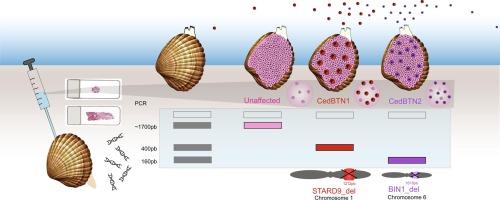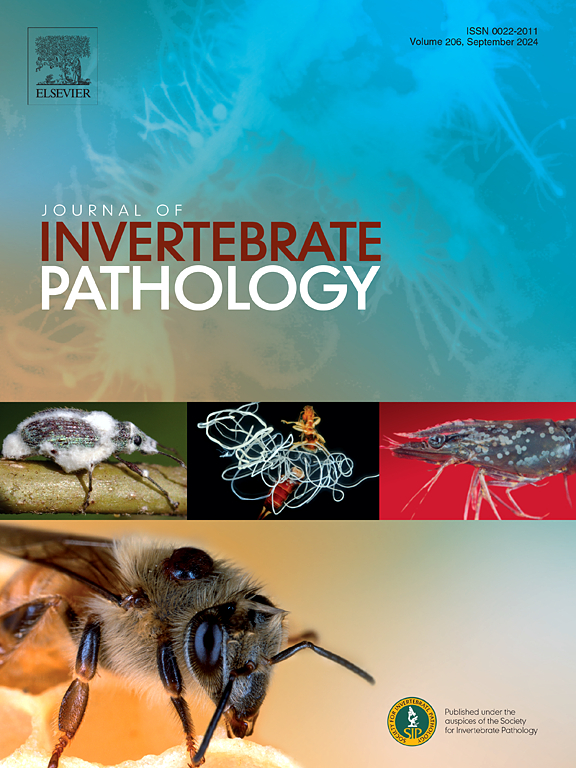用于鉴定 Cerastoderma edule 两种传染性癌症的新型 PCR 检测方法。
IF 3.6
3区 生物学
Q1 ZOOLOGY
引用次数: 0
摘要
传染性癌症是一种罕见的现象,即癌细胞在个体之间传递,导致宿主机体发生肿瘤。在哺乳动物和双壳类动物中分别发现了三个独立的克隆系和八个不同的克隆系中存在可传播的癌症。这项研究的重点是开发一种多重 PCR 检测方法,用于检测毛蚶的两种双壳类传染性肿瘤(BTN)(CedBTN1 和 CedBTN2)。采用最大似然估计法对 88 个样本的血淋巴样本进行了评估,并与组织学诊断结果和基因组分析确认的诊断结果进行了比较,评估了新型 PCR 的诊断灵敏度(Se)和特异性(Sp)。结果显示,CedBTN1 的 Se 为 100%,Sp 为 98.1%,CedBTN2 的 Se 和 Sp 均为 100%。使用从受感染和未感染的 C. edule 及其他受 BTN 影响的双壳类动物中提取的 DNA 对分析 Sp 和 Se 进行了测试。检测结果表明,分析灵敏度和特异性都很高,在 CedBTN1 细胞占 85.7% 的毛蚶血淋巴样本中,当 DNA 浓度为 0.05 纳克/微升时,可检测到低至 0.4% 的循环 CedBTN1 细胞。多重 PCR 检测对 CedBTN 具有类型特异性,并能同时检测两种细胞系。总之,这种多重 PCR 检测法是检测毛蚶传染性癌症的可靠工具,有助于诊断和监测该疾病。本文章由计算机程序翻译,如有差异,请以英文原文为准。

Novel PCR assay for the identification of two transmissible cancers in Cerastoderma edule
Transmissible cancers are a rare phenomenon in which cancer cells are passed between individuals, leading to the development of neoplasia in the host organism. Transmissible cancers have been identified in three independent clonal lineages in mammals and eight different clonal lineages in bivalves. This study focused on the development of a multiplex PCR assay for the detection of two types of bivalve transmissible neoplasias (BTN) of cockles Cerastoderma edule (CedBTN1 and CedBTN2). The diagnostic sensitivity (Se) and specificity (Sp) of the new PCR of hemolymph samples were assessed using a maximum likelihood estimation in the 88 samples compared to diagnoses obtained by histology and confirmed with genomic analyses. The results showed a Se of 100 % and a Sp of 98.1 % for CedBTN1, and a Se and Sp of 100 % for CedBTN2. The analytical Sp and Se were tested using DNA extractions from infected and non-infected C. edule and other bivalves affected by BTN. The assay demonstrated high analytical sensitivity and specificity, detecting down to 0.4 % of circulating CedBTN1 cells at a DNA concentration of 0.05 ng/µL in a hemolymph sample of a cockle with 85.7 % of CedBTN1 cells. The multiplex PCR assay was type-specific for CedBTN and capable of detecting both lineages simultaneously.
Overall, this multiplex PCR assay is a reliable tool for the detection of transmissible cancers in cockles which will facilitate the diagnosis and monitoring of the disease.
求助全文
通过发布文献求助,成功后即可免费获取论文全文。
去求助
来源期刊
CiteScore
6.10
自引率
5.90%
发文量
94
审稿时长
1 months
期刊介绍:
The Journal of Invertebrate Pathology presents original research articles and notes on the induction and pathogenesis of diseases of invertebrates, including the suppression of diseases in beneficial species, and the use of diseases in controlling undesirable species. In addition, the journal publishes the results of physiological, morphological, genetic, immunological and ecological studies as related to the etiologic agents of diseases of invertebrates.
The Journal of Invertebrate Pathology is the adopted journal of the Society for Invertebrate Pathology, and is available to SIP members at a special reduced price.

 求助内容:
求助内容: 应助结果提醒方式:
应助结果提醒方式:


